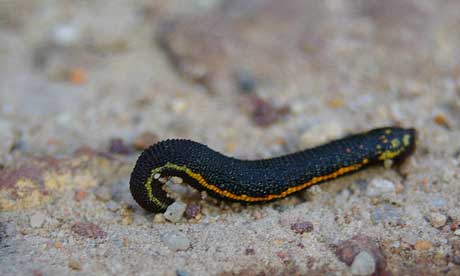
Leeches, flesh-maggots, metre-long guinea worms...Get the help you need to deal with nature's nasties
In the film The Matrix, Keanu Reeves has a nightmare in which a parasitic crustacean is implanted into his body. He then wakes to discover that something really is crawling around inside him – the following scene of its extraction is stomach-churning.
This is in the movies, but are there really creatures that can burrow inside you during your travels?
There are a range of parasites that can set up home in humans. One of the commonest is larva migrans, or the ‘geography worm’ – it wanders under the skin and draws itchy, red map-like lines.
The worm, which is a dog or cat tapeworm, gets in through bare skin that has been in contact with sand or soil contaminated with cat or dog poo. It will die after some weeks but can be dispatched by freezing its head with liquid nitrogen.
There are more vigorous, though less common, forms of larva migrans caused by unpleasant strongyloides worms. These cause rapidly moving red wheals, often around the buttocks and trunk, and can recur over years if left untreated.
More horrific is the guinea worm, aka dracunculiasis or the ‘fiery serpent’. You catch it by accidentally swallowing 1-2mm long water fleas when you take a gulp from an unsanitary source in Sudan or West Africa. The mature female worm that develops from the larvae within the water flea can grow up to a whopping 1m long.
What’s really nasty about these creatures is that the female sticks her egg-laying end out through an ulcer in the skin of your leg; through this she discharges her eggs whenever she senses she is in water. The ulcer readily gets infected while the worm lives.
The treatment is to slowly pull the worm out – over a matter of days – by wrapping it around a stick.
I am pleased to say that this parasite is rare. Most cases are among the very poor of Burkina Faso, Nigeria, Ghana and Sudan.
A friend returned from a trip to the Amazonas of Ecuador with a boil just to the side of his nose. The boil enlarged and my friend felt and heard movement within it. He took a look and could see a creature moving inside. He tried to squeeze it out, but to no avail. Finally my friend went to his doctor who arranged to have the lodger cut out.
This kind of flesh maggot hitches rides on mosquitoes in the tropical Americas, while in Africa the mother bot-fly lays her eggs on drying laundry. When the egg comes into contact with a bit of warm mammal it hatches and penetrates the skin. The African variety can cause crops of ‘boils’ all over the back (from infested sheets) or over the buttocks (if eggs have been laid on undies).
There are many parasites that can enter you by way of raw seafood or other raw wildlife delicacies, with quite a selection to choose from in South-East Asia. For example, beware of eating ‘jumping salad’ in the Philippines (the shrimps in it are so fresh that they jump and squirm when you squeeze lemon on them) – you put yourself at risk of the debilitating disease capillariasis. Or there are the revolting gnathostome worms that form lumps (of parasite) under your skin, also picked up from eating raw or undercooked crustacea.
Your extremities are not safe in cold climates either. Not keeping warm and dry means that your feet can become macerated, stinking and infected. If any appendage also gets frozen solid, the consequences are longer lasting than anything a worm will do. Tissue that is frozen is starved of blood and dies.
Often gentle re-warming and cushioning of the frozen part will save the frost-bitten limb but things look disgusting during the healing process: as my husband’s frost-bitten big toe started to recover, the skin of the whole toe just slid off like the finger of a rubber glove. The raw toe was festering by the time he returned home, so his Tibetan landlady treated him with bears’ bile and extract of musk deer. Even with antibiotics, the infection took weeks to settle.
One of the problems of travel is that people love telling tales. There are some amazing stories about where leeches can slither: for example, squaddies in South-East Asia believed leeches could crawl up the urethra, so took to wearing condoms while sleeping.
I know of no truth in this leech tale, but the candiru fish of South America is better designed to sneak into tight places – it is adapted to cling on inside the gills of catfish. The candiru does not, however, usually penetrate very far. They are a rare problem, most likely in boys bathing in pools at the end of the dry season.
The award for Most Gruesome Affliction must go to a creature from West Africa. It is the 7cm-long loa loa worm, spread by the bite of a horsefly-like insect, which can live within humans for up to 15 years. It migrates around the body and can sometimes be seen moving under the skin and transiting under the conjunctiva across the surface of the eye.
The good news about all these ailments is that none are of the scale of Keanu’s parasite and none will afflict the well-clad and bite-protected venturer.
Dr Jane Wilson-Howarth has a particular loathing of parasites, developed while working in Asia, Peru and Madagascar